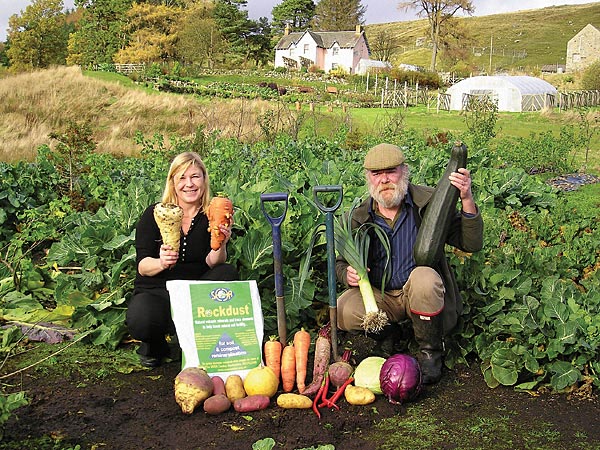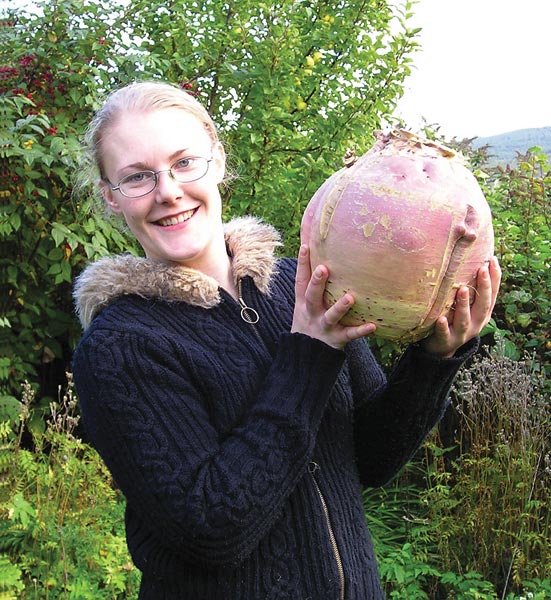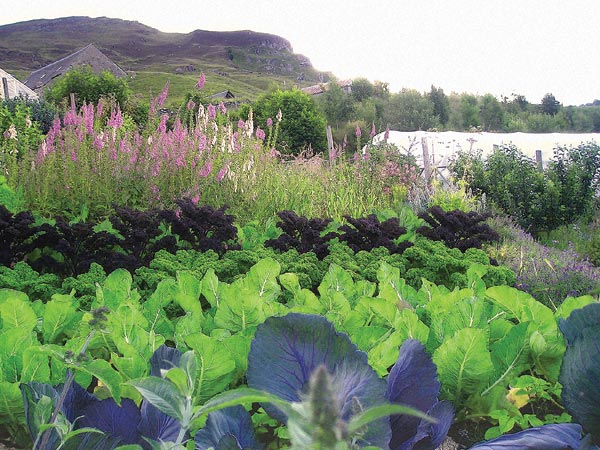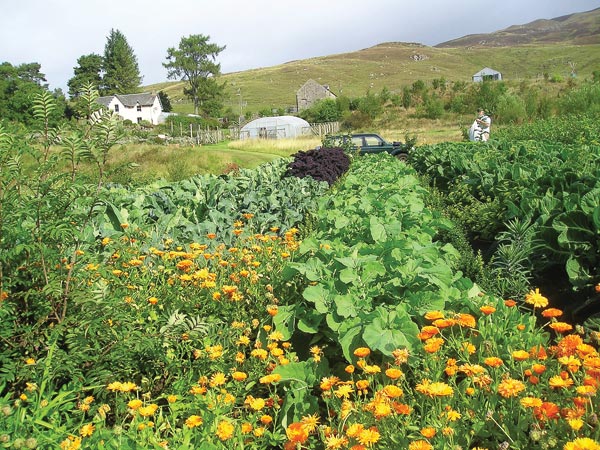Transforming Barren Land Into Fertile Ground
If you were to choose a place to plant your dream vegetable garden, it would probably not be in the foothills of the Grampian Mountains in Strathardle, Perthshire, Scotland. The upland site is infertile, acidic and exposed to severe weather. Around 85 percent of Scotland is classified by the European Union as a “less-favoured area” for farming, and this region, plagued by lifeless, silty soil and boulders, falls right into that category.
Yet it was exactly here that Cameron and Moira Thomson settled and decided to become self-sufficient by creating their own garden, growing their very own fruits and vegetables. “Our dream was to grow and use our own food, and to live as much from the local environment as possible and as little from the shops as possible,” Moira Thomson told Organic Connections. “So we dedicated our lives to that—but it was hard work with such poor soils.”
In 1984, the couple happened to be listening to the radio one day and heard the review of a book entitled The Survival of Civilization by John Hamaker and Donald Weaver. The book describes the function of ice ages as that of glaciers crushing rock, releasing nourishing minerals into the earth, and the fact that, at present, minerals are nearly gone from the soil. Armed with this new information about soils, the Thomsons had the answers they had been seeking.
“We read this book and we thought, This is it; now we’ll be able to grow the proper crops that will sustain us,” said Thomson. “It just made such sense to us it seemed right. So we started to use quarry dusts in our gardens and have never looked back.”

The dust Thomson is referring to is obtained from the nearby Collace Quarry, operated by Tayside Contracts. They suddenly saw their gardens come alive—quite literally. “We’re totally hooked. It definitely works,” Thomson remarked. “Not only does it put minerals back in the soil, it consequently grows giant vegetables—giant lovely vegetables that are full of minerals and trace elements that are missing in most of today’s soils.”
The beneficial effects of glaciers are replicated when rock dust is used. Sprinkled on top of the land, rock dust is digested by earthworms and thereby combined with organic matter containing nitrogen, carbon, minerals and thousands of microorganisms, ultimately becoming organic mineral-rich plant food. The process is known as remineralization.
Remineralization also causes absorption of a higher amount of carbon from the atmosphere, locking it into soils and into mineral-rich plants. “In addition to growing wonderful food to feed the world, you can also take carbon out of the atmosphere and help stabilize climate change,” Thomson said.
The Thomsons are certainly not alone in their discoveries. Some of the world’s top chefs, including Alice Waters and Dan Barber, have discovered in their search for the ultimate in tasty ingredients the enormous benefits of remineralized farming. Waters’ Chez Panisse and Barber’s Blue Hill restaurants each feature remineralized produce.
As pointed out by Moira Thomson, there is the issue of nutrition as well. Dr. Arden Andersen, both a soil consultant and a medical doctor, has found that the nutrient content of foods today compared to half a century ago ranges from 15 to 75 percent less—due to depletion of nutrients in the soil. Restoration of the soil nutrients brings back the full nutritional benefits to fruits and vegetables.
Telling the World
The Thomsons were so impressed with their results they decided to make it their life’s mission to export their findings to the farmers who could really use the information. After 13 years of pioneering work, they established the SEER Centre in 1997, a charitable organization committed to regeneration of soils to benefit the grower and the environment. SEER is an acronym for Sustainable Ecological Earth Regeneration. Armed with two shovels and a wheelbarrow, along with the rock dust and Dundee Council’s award-winning locally made compost, they had their magic formula for soil creation. Beginning with 220 tons of these resources, they created two deep terraces of “Rocksoil” in which to grow their vegetables, and thus began the building out of the remarkable showplace that the Centre would become.
 By July 1997, the Thomsons’ five children were biting into the first of the Centre’s remineralized crops, and by 2000 the young remineralized trees were beginning to grow profusely, providing shelter and wildlife habitats around the perimeter.
By July 1997, the Thomsons’ five children were biting into the first of the Centre’s remineralized crops, and by 2000 the young remineralized trees were beginning to grow profusely, providing shelter and wildlife habitats around the perimeter.
And the word did spread. First it was local media, then national media, then international media. The esteemed BBC aired television news items and specials focusing on the SEER Centre and the work of Cameron and Moira Thomson.
“It was a publicity campaign from the start, trying to attract attention to what we were doing,” Moira Thomson related. “It started locally, and eventually it widened out and became more national, and we’ve had quite a bit of international interest too. A leading Swedish daily newspaper came over in 2006 and did a big spread—a cover story. This was after they had learned of the release of a book called We Want Real Food by Graham Harvey, in which he addresses the decline of minerals in modern foods. We’ve since gone to Sweden to launch our ‘Rockdust’ product and organized a supplier over there. Swedish TV News has also featured our achievements.”
Today the SEER Centre is open at different stages of the growing season, offering tours, courses and working holidays. Cameron and Moira will even travel to give talks and demonstrations of their discoveries. The SEER Centre Trust owns a trading subsidiary, Rockdust Limited, which sells their very own brand of minerals, called Rockdust, all over the UK and beyond. Sales information links can be accessed directly from the Centre website. They make and sell two different rock-dust/compost mixes as well: “Rocksoil”—their growing medium, which is in the SEER Centre terraces—and “Rockmix,” the top dressing used at SEER Centre, an organic chemical-free fertilizer. Proceeds all go to support the Centre and its activities.
The Results
A good measure of the results of remineralization at the SEER Centre comes in the example Moira Thomson gives of their growing of potatoes.
“We have also done trials here at SEER Centre with soil, simply because we want our visitors to see the remineralized, rich compost soils alongside the poor soil that is naturally here,” Thomson said. “You can grow potatoes in the native soil, but they’re not high yielding.
“So on half of a soil terrace we went with no rock dust and on the other half we put rock dust. We had bigger plants and bigger  crops on the rock-dusted side, bigger potatoes. We reckon we quadrupled the yield in comparison with the original soil, because not only did we have bigger potatoes but we had more of them.”
crops on the rock-dusted side, bigger potatoes. We reckon we quadrupled the yield in comparison with the original soil, because not only did we have bigger potatoes but we had more of them.”
The Thomsons have found a successful formula in their Rocksoil blend. Compost is mixed with rock dust in specific quantities and it lasts for years. For the first 12 years they simply planted into the Rocksoil mixture and added no more rock dust, taking bumper crops year after year. Even though it didn’t seem to need it, they’ve recently added more rock dust, just because they recommend it be added every 5 to 10 years.
In another experiment, the Thomsons discovered the potency of the rock dust by itself, even without compost-enriched soil. Within a greenhouse, they divided up two areas separated by a cement and brick path, with a deep rubble infill to prohibit the passage of worms between the trial areas. One side contained compost and rock dust, while the other contained poor soil and rock dust. Both sides grew equally giant tomatoes!
Into the Future

The SEER Centre is now up to 11 thriving terraces and a large bed where they grow a full range of produce as well as bushes, hedges and fruit trees. “We grow as many different things as possible to make a whole biodiverse ecosystem,” Thomson explained, “and we try to show as many different plants as possible so different kinds of growers can see how their particular specialty would grow with rock dust.”
The success of their venture can be seen simply by its contrast with the surrounding landscape. “It’s very much an ‘oasis in the glen,’ as we call it,” said Thomson. “It’s lush growth surrounded by hedges, which we’ve created since we came here. The rest of the landscape is very barren and bleak—Scottish hillsides with lots of sheep on them.”
The SEER Centre is connected with Remineralize the Earth (RTE), an organization that helps facilitate projects such as SEER Centre the world over. “Remineralize the Earth has been closely aligned with the Thomsons since the 1980s,” said Joanna Campe, RTE’s executive director. “Cameron and Moira are pioneers of turning barren lands into incredibly fertile soils with the addition of rock dust; and with a minimum of garden maintenance they are demonstrating the potential of remineralization to SEER Centre visitors on a daily basis as well as through the enthusiastic media coverage they receive from the BBC and others. Seeing these dramatic results from the Thomsons and various growers elsewhere has sustained my mission for the last 25 years to remineralize and regenerate soils everywhere.”
With the help of volunteers and contributions from around the planet, the SEER Centre continues its remarkable work. To find out more, and to learn how you can help, visit the SEER Centre website at www.seercentre.org.uk.
Reprinted with permission from Organic Connections Magazine
Support us on Patreon
Thank you for joining us today! Please become a member of RTE and support us on Patreon. Unlike many larger organizations, we work with a team of determined and passionate volunteers to get our message out. We aim to continue to increase the awareness of remineralization to initiate projects across the globe that remineralize soils, grow nutrient dense food, regenerate our forests’ and stabilize the climate – with your help! If you can, please support us on a monthly basis from just $2, rest assured that you are making a big impact every single month in support of our mission. Thank you!








Archie Mishkin
December 11, 2013 (10:25 am)
It is difficult to discover well-informed men and women on this issue, however, you give the impression you know what you need to know! Thank you.
GEETHA
December 17, 2015 (9:18 am)
Dear Cameron and Moira you are a true inspiration to our mother earth and all nature lovers.I am planning to start organic farming and your article motivates me a lot.Thank you for being a blessing to the human race.
Solomon Steeley
November 21, 2022 (3:35 pm)
How do I purchase quarry dust, and is it a matter of just mixing it with my top soil.
Joanna Campe
November 27, 2022 (10:49 am)
I would recommend downloading our Rock Dust Primer from the homepage, and that will have answers to all your questions!
Link here: https://www.remineralize.org/a-rock-dust-primer/